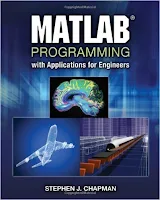MATLAB Programming with Applications for Engineers
Stephen J. Chapman ... 592 pages - Publisher: CL-Engineering; 1st edition (January, 2012) ... Language: English - ISBN-10: 0495668079 - ISBN-13: 978-0495668077 ...
MATLAB Programming with Applications for Engineers seeks to simultaneously teach MATLAB as a technical programming language while introducing the student to many of the practical functions that make solving problems in MATLAB so much easier than in other languages. The book provides a complete introduction to the fundamentals of good procedural programming. It aids students in developing good design habits that will serve them well in any other language that he or she may pick up later. Programming topics and examples are used as a jumping off point for exploring the rich set of highly optimized application functions that are built directly into MATLAB.
MATLAB Programming with Applications for Engineers seeks to simultaneously teach MATLAB as a technical programming language while introducing the student to many of the practical functions that make solving problems in MATLAB so much easier than in other languages. The book provides a complete introduction to the fundamentals of good procedural programming. It aids students in developing good design habits that will serve them well in any other language that he or she may pick up later. Programming topics and examples are used as a jumping off point for exploring the rich set of highly optimized application functions that are built directly into MATLAB.





